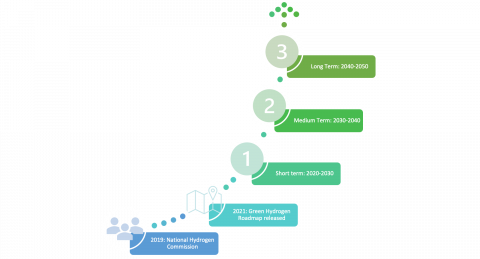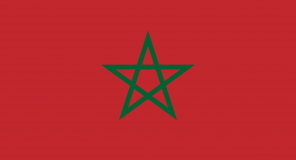Morocco
Green hydrogen vision
The Kingdom of Morocco aims to create an economic and industrial sector around green molecules, particularly hydrogen, ammonia, and methanol, to consolidate its energy transition by contributing to reducing greenhouse gas emissions and supporting decarbonisation in partner countries.
Morocco has exceptional potential in renewable energy sources, which combined with its expertise will provide momentum to the green hydrogen development in the country. The aim is to use green hydrogen production to promote its economy and strengthen energy security.
The government envisages that green hydrogen production will add value to renewable electricity production, in particular its transformation into products with higher energy density. The demand potential in large economies and markets like Europe represents an opportunity to export green energy. Establishing a national industry based on green hydrogen is also aimed at replacing ammonia imports with local production.
“We can develop win-win alliances and position ourselves as an African green hydrogen hub.” Samir Rachidi, Director general, IRESEN
National Strategy
The Moroccan Ministry of Energy, Mines and Environment set out a roadmap on green hydrogen in 2021 under the National Hydrogen Commission (created in 2019). The country is expecting a demand up to 30 TWh by 2030 and 307 TWh by 2050, that would require 2GW in renewable energy sources.
The strategy is based on three pillars: market and demand, with recommendations to create better export and storage conditions, technology facilitating cost reductions and local industrial integration, and investment that identifies possible clusters and measure for its financing. Morocco has an established renewable energy model and a decent geographical positioning, with proximity to Europe and pre-established energy interconnection infrastructure, that makes its potential for green hydrogen even better.
The strategy considers 3 phases of development:
- 2020-2030: The short term considers the local use as a raw material and exports to targeted countries. The development is based on pilot projects using government and international financial support. This period will witness higher costs of production.
- 2030-2040: The medium-term explores the opportunities to reduce production costs and local usage of green hydrogen in the electricity sector.
- 2040-2050: In the long term, the roadmap will improve the business case for green hydrogen at the world level. It includes expansion of usage to the heat production sector for residential and urban mobility usage, including heavy vehicles and aviation.
The strategy also strongly supports the local production of ammonia, an industry where Morocco has so far relied on imported ammonia to meet its needs.

Capacity and Price
-
By 2030, the country envisages a local hydrogen market of 4 terawatt hours (TWh) and an export market of 10 TWh, which, taken together, would require the construction of 6 GW of new renewable capacity and support the creation of more than 15 000 direct and indirect jobs (MEM, 2021).
-
The World Energy Council study estimated the global market for green hydrogen and its derivatives at 20,000 TWh in 2050. On the assumption by the Kingdom of Morocco that in 2030, this global market would represent 600 TWh- a study “Economic Opportunities of Power-to-X in Morocco” demonstrated that Morocco could capture up to 4% of this global demand by 2030.
-
Based on the calculations in the country’s roadmap, it is estimated that the green hydrogen industry and its derivatives in Morocco could meet a demand of between 13.9 TWh and 30.1 TWh in 2030, which could reach between 153.9 TWh and 307.1 TWh in 2050.
Impact Targets
Head of Government Aziz Akhannouch announced the "Morocco Offer" on March 11, 2024, to boost Morocco's green hydrogen sector in Rabat. Inspired by HM King Mohammed VI, this initiative aims to make Morocco a competitive force in the global market.
The “Morocco Offer” encompasses the green hydrogen value chain, leveraging the country’s natural resources, strategic location, and infrastructure. By promoting renewable energy and attracting investment, Morocco aims to play a vital role in global energy transition.
This plan outlines implementation stages, resource mobilization, infrastructure development, incentives, investor selection, and governance. It covers integrated projects from renewable energy generation to hydrogen production.
The State has allocated one million hectares of public land to encourage investment, starting with 300,000 hectares for investors. The investment framework includes regular assessments and transparent communications to ensure project advancement and mutual success.
With nearly 100 national and international investors interested, the “Morocco Offer” highlights the Kingdom’s potential in green hydrogen. As Morocco embarks on this journey, green hydrogen is set to drive sustainable growth and position the nation prominently in the global energy landscape.
Policy Spotlight
Policy Spotlight:
a) Creation of favourable conditions for export: The development of a green hydrogen export industry and its derivatives will be made mainly through the establishment of maritime transport of synthetic liquid fuels, the deployment of port infrastructure adapted as well as the deployment of production and storage infrastructures and export.
b) Development of domestic markets: The government will support the industry by organizing exchanges of information and platforms that can serve as a basis for coordinated planning of different parts of the industry, in addition to the support for R&D, scaling up by providing grants and research tax credits.
Project Spotlight:
- GreenH2A: Green Hydrogen & Applications Park" is a research platform that aims to be a national, regional, and continental reference in terms of R&D and Innovation. This platform will deal with subjects relating to the “Power-To-X” sector, in particular hydrogen, ammonia, green methanol, and the various synthetic fuels, as well as themes related to desalination and water treatment.
- Natural Hydrogen: National Office of Hydrocarbons and Mines (ONHYM) is investigating the existence of hydrogen present in its natural form in underground deposits. Two areas have already been identified during the mapping and modelling by ONHYM, where there is significant concentrations available.
- Morocco Hydrogen Cluster: The ambition of the cluster is the organization of the green hydrogen sector and derivatives at the national level, by interacting with regional actors and by connecting all of its parties’ stakeholders. The clustering of the different actors will be both physical and virtual and will make it possible to implement its three different dimensions: economic, relational, and territorial.
- German Moroccan Energy Partnership (PAREMA): The Moroccan Government within the German Moroccan Energy Partnership (PARMA) signed an active partnership to advance green hydrogen, and is developing a roadmap to 2050 to develop the green industry in Morocco. In June 2020, the Germany-Morocco Hydrogen Agreement was signed in Berlin for the joint development of the production of green hydrogen for its use in Morocco and Germany. An investment of €300 million has already been pledged, allowing Germany to source green hydrogen from Morocco in the future.
- Total Energies Project: Total Energies is targeting to set up a plant with a green hydrogen production capacity of 10 GW of clean electricity in the Guelmim-Oued Noun of Morocco starting 2027. This implementation is expected to term Morocco as one of the most advanced African countries after Namibia in the development and production of green hydrogen.
- CMMZE Invest UAE and Gaia Future Energy have forged a Joint Development Agreement to collaborate on a groundbreaking green hydrogen project in Guelmim, Morocco. This partnership underscores both firms' commitment to advancing renewable energy efforts and positioning Morocco as a key player in the green hydrogen sector. CMMZE Invest UAE will focus on enhancing the project's technical aspects, including developing technologies for hydrogen production, storage, and transportation. CEO Alex conveyed his excitement about working with Gaia Future Energy, highlighting the promise of their joint efforts to promote a sustainable future by integrating CMMZE’s technological advancements with Gaia’s extensive expertise in renewable energy. The project is set to deploy a 200 MWe electrolyser capacity, utilizing wind, solar, and battery storage to generate hydrogen for export through the Port of Agadir. This venture aligns with Morocco’s goal of becoming a global leader in green hydrogen production, with an anticipated completion date of 2025.
Additionally, in March 2025, the Moroccan government approved five investors for six green hydrogen projects worth a total of $32.8 bn. The consortium of investors composed of United States’ Ortus, Spain’s Acciona and Germany’s Nordex will invest in the production of green ammonia, while another consortium of investors composed of the AUE’s Taqa and Spain’s Cepsa will invest in the production of ammonia and industrial fuel. Morocco’s Nareva will invest in the production of green ammonia, fuel and steel, and the Saudi company ACWA Power will produce green steel. Finally, a consortium of Chinese investors composed of UEAG and China Three Gorges will produce ammonia.
Financing
-
In the green hydrogen roadmap, it is estimated that the development of the green hydrogen industry in Morocco would require an investment of 140 billion dirhams (€13 billion) up to 1,000 billion dirhams (€95 billion) between 2020 and 2050 to meet the potential demand by 2050.
-
Total Energies is investing €9.4 billion in a green hydrogen and green ammonia project to set up facilities in the Guelmim-Oued Noun of Morocco.
-
The German Power-to-X Development Fund is inviting project proposals from Morocco and other nations to participate in an important funding initiative. Supported by a €270 million grant, this program aims to boost green hydrogen production and emphasizes Morocco's expanding position in the renewable energy arena. The funding is intended to enhance project profitability and facilitate access to additional financial resources.
Government Green Hydrogen Lead
The Moroccan Ministry of Energy, Mines and Environment
Research Institute for Solar and New Energies (IRESEN)
